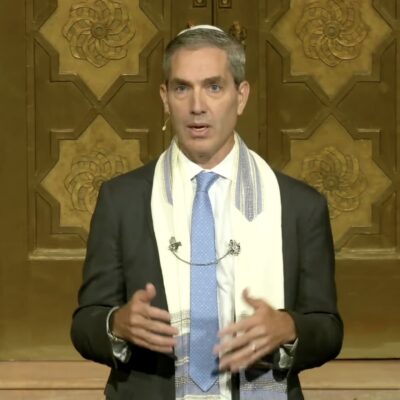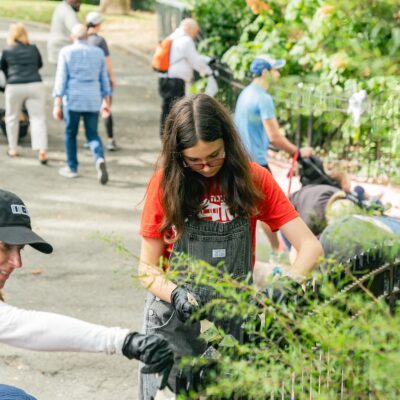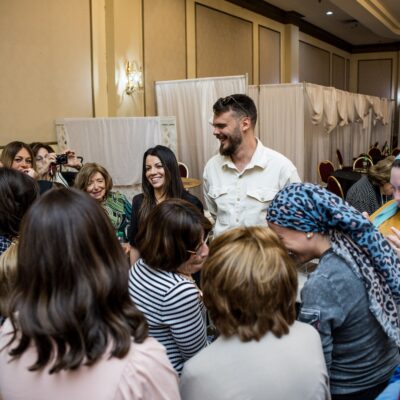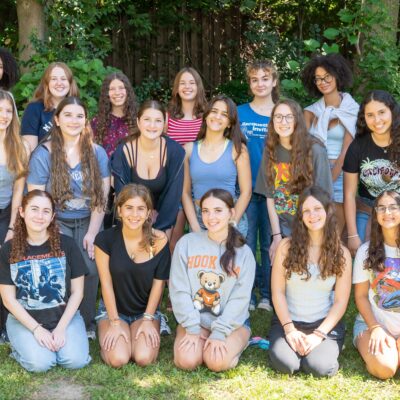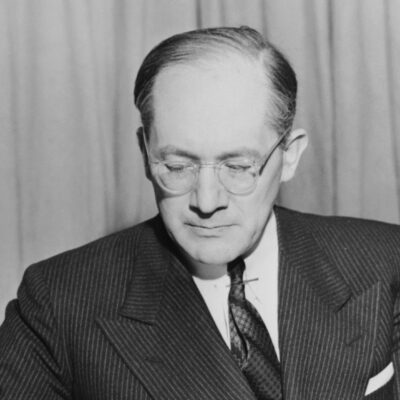Opinion
The Timely Power of Art

By Rebecca Guber
If you wandered through Boston Common last April, you would have likely stumbled onto “Pathways to Freedom,” a large-scale public art installation.
Artist Julia Vogl placed 1,800 colorful vinyl circles around the Soldiers and Sailors Monument, and each circle in the artwork represented one individual’s answers to four questions reflecting on freedom. The research for this project was funded by Asylum Arts and it was commissioned by the Jewish Arts Collaborative.
The originality, scale and participatory nature of the project sparked conversation both in-person and online. The installation was widely covered by the media, engaging even more people than the nearly 2,000 Bostonians who responded to prompts about the Passover themes of freedom and immigration to generate the content for the public presentation.
Ms. Vogl’s installation is an example of art’s unique and layered ability to create meaningful ways for diverse groups of people to engage with Jewish culture: ideas, history, art and wisdom.
Studies show that Millennials (and I would argue the youth of every generation) are hungry for creative ways to explore and express their identities. Art helps people to better understand themselves and to share that newfound sense of understanding and inspiration with the world.
It is this power that I wanted to nurture when I founded Asylum Arts in 2013. Asylum Arts supports a network of emerging Jewish artists, fostering community and partnership across countries and disciplines. It is also in the process of proving an important theory: that art is an essential tool for helping people to engage with Jewish culture and identity.
We are not the first ones to put this idea to the test. We join a cadre of organizations who believe that a thriving Jewish arts and culture scene is fundamental to sustaining Jewish communal life. We are part of a small group of organizations that work directly with artistic creators, including our collaborators Artis, LABA: A Laboratory for Jewish Culture, and the Institute for Jewish Creativity at AJU.
At Asylum, we are committed to strengthening Jewish culture by investing in poets, filmmakers, choreographers, visual artists, playwrights and others engaging with audiences through their creative work.
Through our Small Grants Program, we have already funded 165 artistic projects that explore Jewish and Israeli history and thought. We estimate that these performances, exhibitions and events engaged over 1 million people across the globe. Indeed, we are proud that from Ukraine to Tunisia, Sweden, Argentina and beyond, Jewish artists can turn to us for support in getting their projects off the ground. With the Small Grants Program, Asylum Arts is currently the largest direct funder of Jewish artists internationally, providing the most significant source of support available to Jewish artists. And particularly crucial in this contemporary moment, these events and performances are open and welcoming, providing essential avenues for otherwise unengaged Jews as well as non-Jewish audiences looking to learn about Jewish life.
We are also helping emerging Jewish artists to leverage their potential by fostering strong, authentic relationships with each other. To date, Asylum has brought together 600 artists from 29 countries. Our retreats give artists the chance to get in touch with their own Jewish identities, share knowledge and build community. Participants tell us how meaningful it is to have a place where they can allow their identities – artistic, Jewish and otherwise – to meld. As one artist put it, “I think as a secular Jew, it can be easy to take certain things for granted, but in the past I week I realized that I want to engage more deeply and creatively with my Jewishness.”
To fully assess our impact, we also want to understand how audiences engage with Jewish and Israeli art. How do those who are not usually exposed to Jewish artistic expression react? Will this experience change the way people think? These are the kinds of questions we had in mind when we commissioned Dr. Tobin Belzer to conduct an exploratory qualitative study on the impact of Asylum artists’ work. After in-depth interviews with 10 audience members of diverse backgrounds, we found that the art:
- Changed audience members’ attitudes: after viewing contemporary articulations of Jewish history, culture and identity, audience members thought more highly of and were interested in experiencing more Jewish and Israeli art.
- Affected audience members’ behaviors: audience members expressed feeling moved to cultivate their own creativity, and to incorporate their unique stories and sense of Jewish identity into their work.
- Increased audience members’ knowledge: As one audience member described, “I got a geography lesson. I haven’t been to Israel since I was a little girl. My memory is abstract. The performance gave me a sense of the country I didn’t have before: the climate, mountains, country … it provided a sense of place.”
The study also showed that these effects strengthened over time. A few months after the initial interviews, audience members reported how the initial encounter influenced their experience of other artistic events and has continued to motivate them to seek out avenues of personal and Jewish expression.
The more positive the findings, the more convinced we are of the need to invest in this field. We are grateful to all those who have made our work possible and hope that more donors recognize the crucial role artists have in shaping a vibrant Jewish future.
Just as it did at Boston Common, art has a way of helping us to see the world and each other differently. Now is the time to invest in people who are summoning the creativity it takes to expand our minds as well as our hearts.
Rebecca Guber is the Director and Founder of Asylum Arts, and previously was the Founding Director of the Six Points Fellowship for Emerging Jewish Artists. She is a Schusterman Fellow and ROI Community member.

 Add EJP on Google
Add EJP on Google